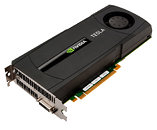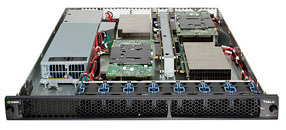Monday, November 16th 2009

New NVIDIA Tesla GPUs Reduce Cost Of Supercomputing By A Factor Of 10
NVIDIA Corporation today unveiled the Tesla 20-series of parallel processors for the high performance computing (HPC) market, based on its new generation CUDA processor architecture, codenamed "Fermi".
Designed from the ground-up for parallel computing, the NVIDIA Tesla 20-series GPUs slash the cost of computing by delivering the same performance of a traditional CPU-based cluster at one-tenth the cost and one-twentieth the power.The Tesla 20-series introduces features that enable many new applications to perform dramatically faster using GPU Computing. These include ray tracing, 3D cloud computing, video encoding, database search, data analytics, computer-aided engineering and virus scanning.
"NVIDIA has deployed a highly attractive architecture in Fermi, with a feature set that opens the technology up to the entire computing industry," said Jack Dongarra, director of the Innovative Computing Laboratory at the University of Tennessee and co-author of LINPACK and LAPACK.
The Tesla 20-series GPUs combine parallel computing features that have never been offered on a single device before. These include:
"There can be no doubt that the future of computing is parallel processing, and it is vital that computer science students get a solid grounding in how to program new parallel architectures," said Dr. Wen-mei Hwu, Professor in Electrical and Computer Engineering of the University of Illinois at Urbana-Champaign. "GPUs and the CUDA programming model enable students to quickly understand parallel programming concepts and immediately get transformative speed increases."
The family of Tesla 20-series GPUs includes:
As previously announced, the first Fermi-based consumer (GeForce) products are expected to be available first quarter 2010.
Designed from the ground-up for parallel computing, the NVIDIA Tesla 20-series GPUs slash the cost of computing by delivering the same performance of a traditional CPU-based cluster at one-tenth the cost and one-twentieth the power.The Tesla 20-series introduces features that enable many new applications to perform dramatically faster using GPU Computing. These include ray tracing, 3D cloud computing, video encoding, database search, data analytics, computer-aided engineering and virus scanning.
"NVIDIA has deployed a highly attractive architecture in Fermi, with a feature set that opens the technology up to the entire computing industry," said Jack Dongarra, director of the Innovative Computing Laboratory at the University of Tennessee and co-author of LINPACK and LAPACK.
The Tesla 20-series GPUs combine parallel computing features that have never been offered on a single device before. These include:
- Support for the next generation IEEE 754-2008 double precision floating point standard
- ECC (error correcting codes) for uncompromised reliability and accuracy
- Multi-level cache hierarchy with L1 and L2 caches
- Support for the C++ programming language
- Up to 1 terabyte of memory, concurrent kernel execution, fast context switching, 10x faster atomic instructions, 64-bit virtual address space, system calls and recursive functions
"There can be no doubt that the future of computing is parallel processing, and it is vital that computer science students get a solid grounding in how to program new parallel architectures," said Dr. Wen-mei Hwu, Professor in Electrical and Computer Engineering of the University of Illinois at Urbana-Champaign. "GPUs and the CUDA programming model enable students to quickly understand parallel programming concepts and immediately get transformative speed increases."
The family of Tesla 20-series GPUs includes:
- Tesla C2050 & C2070 GPU Computing Processors
- Single GPU PCI-Express Gen-2 cards for workstation configurations
- Up to 3GB and 6GB (respectively) on-board GDDR5 memory
- Double precision performance in the range of 520GFlops - 630 GFlops
- Tesla S2050 & S2070 GPU Computing Systems
- Four Tesla GPUs in a 1U system product for cluster and datacenter deployments
- Up to 12 GB and 24 GB (respectively) total system memory on board GDDR5 memory
- Double precision performance in the range of 2.1 TFlops - 2.5 TFlops
As previously announced, the first Fermi-based consumer (GeForce) products are expected to be available first quarter 2010.


53 Comments on New NVIDIA Tesla GPUs Reduce Cost Of Supercomputing By A Factor Of 10
OMG, the IO plate of this card is the exact oppsite of the HD5k series. :roll:Typo on memory.
EDIT: Maybe that doesn't sound impressive yet.
So do you know the typical performance?
How does that compare to lets ay a FireStream?
www.top500.org/
EDIT: Ah, yeah. I forgot Firestream is the Ati GPGPU card, this one seems to be the fastest one: ati.amd.com/technology/streamcomputing/product_firestream_9270.html
It says 250 GFlops of peak double precision. It's hard to say and I'm probably going to be flamed and called fanboy, but the actual throughoutput is probably much much lower. That's the same DP Gflops as a HD4870 card would have (it seems based on RV770 anyway) and based on how the Ati cards perform compared to Nvidia cards in things like F@H, IMO it's real Gflops have to be more like 50 Gflops.
That is the reason I have doubts on its performance.
I am trying to understand this: :p
perspectives.mvdirona.com/2009/03/18/HeterogeneousComputingUsingGPGPUsAMDATIRV770.aspx
@Zubasa, why isn't ATI and Stream with Open CL ready to go against Cuda?
They rather sell Teslas for thousands of dollars instead of hundreds for desktop parts. :respect:
Edit: The nVidia site also states that the Geforce should be ready for Q1, hope that is not a paper launch.Well there is hardly anything that uses OpenCL yet, in fact ATi haven't release drivers that enables OpenCL and DirectCompute on older cards.
"Older" includes all the HD3k and 4k series.
Stream is in a even more pityful state, I hardly knows any software that supports it apart from stuff from Adobe.
Edit: According to Bjorn3D, there are a little more...
www.bjorn3d.com/read.php?cID=1408&pageID=5778
* Adobe Acrobat®Reader: “Up to 20%* performance improvement when working with graphically rich, high resolution PDF files when compared to using the CPU only”
* Adobe Photoshop CS4® Extended: “Accelerated image and 3D model previewing (panning, zooming, rotation) and 3D manipulations to photos, for example mapping an image onto a 3D object”
* Adobe After Effects®CS4: “Allows for the rapid application of special effects to digital media”
* Adobe Flash®10: “Dynamic, graphically engaging Web content designed with these capabilities in mind”
* Microsoft Windows Vista®: “Harness stream processing to make image adjustments on the fly in Microsoft’s Picture Viewer application”
* Microsoft Expression®Encoder: “Accelerated encoding of content for Microsoft®Silverlight™, Windows Media video and audio”
* Microsoft Office® PowerPoint 2007: “Acceleration of slideshow playback for smooth animations, transitions and slide display”
* Microsoft Silverlight: “Unlocking the full potential for web based multi-media and robust user experience and interface”
It's also a high level language* and that makes easier to program for than the other ones which are low-medium level languages.
Nvidia did really put a lot of effort into GPGPU since G80 days and it's really paying off now.
*You can still access low level if you wish, you can get pretty close to silicon.
But now is the question: WHERE IS MY GODDAMNED GTX380 ?!?!?! :D
It comes with CCC suite 9.10. :confused:
PD. I don't even know for sure if it's that TBH. :laugh: